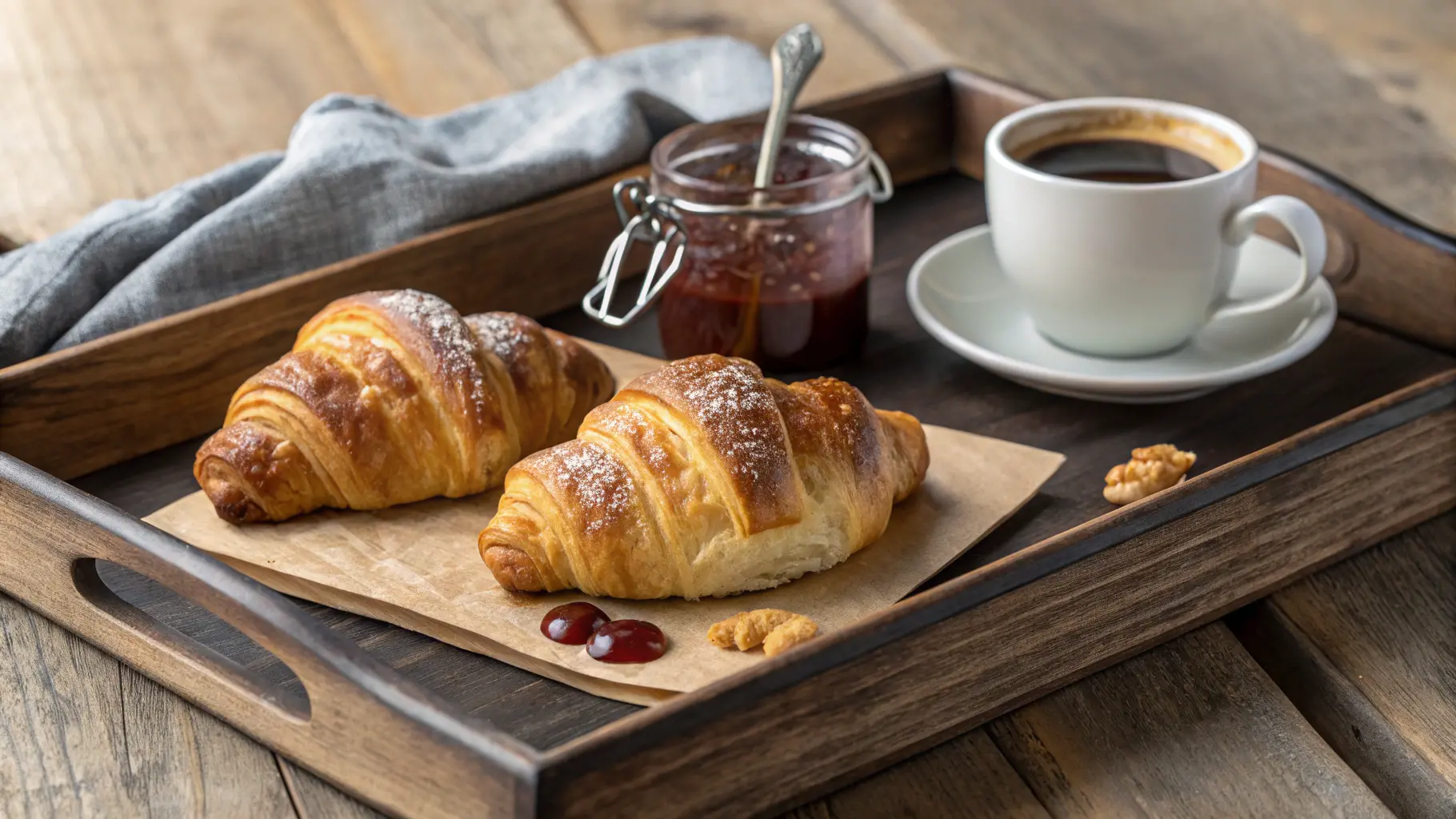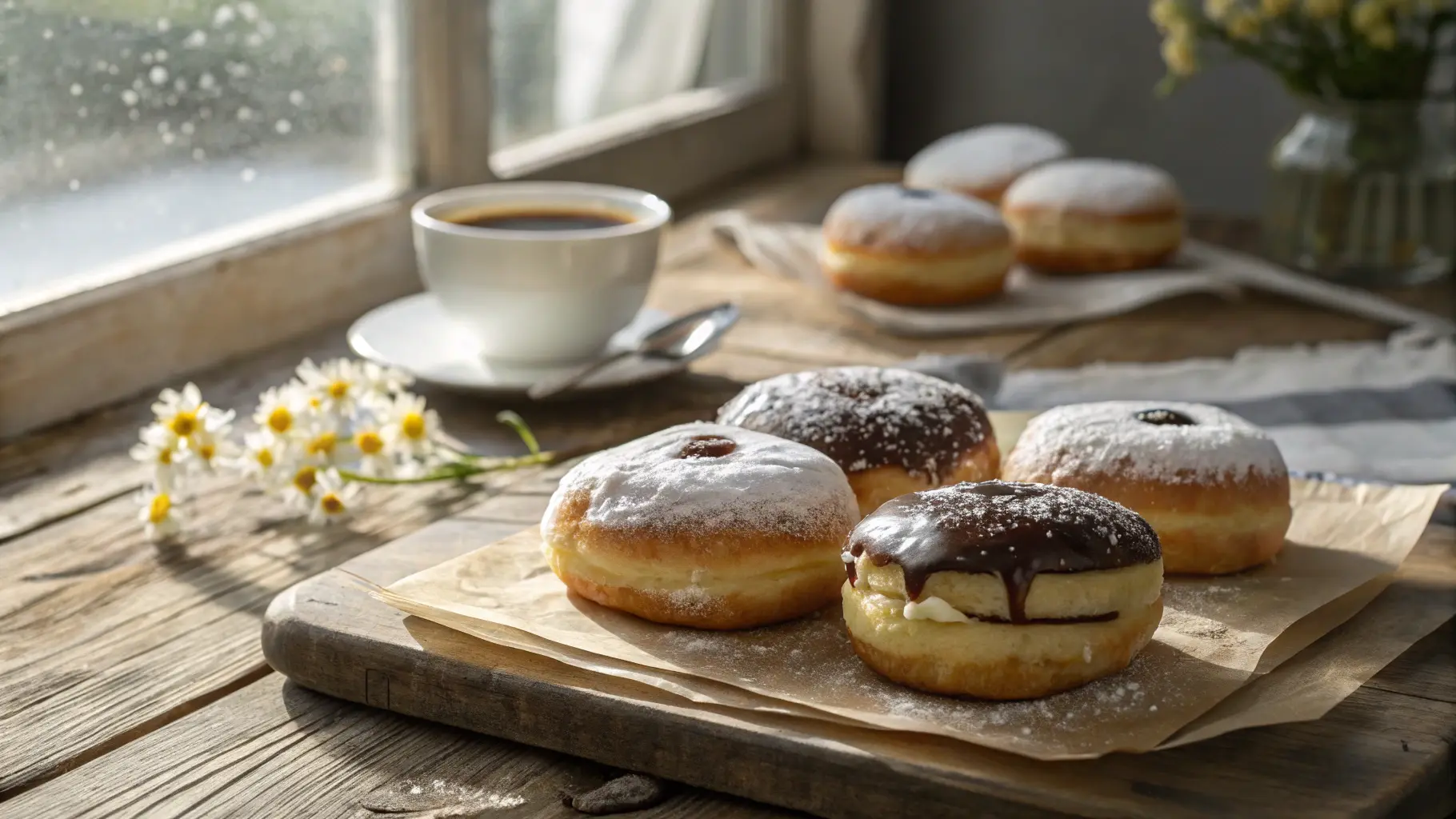Imagine biting into a warm, flaky Gipfeli fresh from the oven—a Swiss pastry that’s golden on the outside, soft inside, and just the right amount of buttery goodness. Known as the Swiss cousin of the croissant, Gipfeli is a breakfast favorite across Switzerland, loved for its crescent shape and versatility. Whether you enjoy it plain, smeared with jam, or stuffed with chocolate, this treat brings a taste of Swiss tradition to your kitchen.
In this guide, we’ll share a foolproof Gipfeli recipe along with seven secrets to make yours the best ever. From perfecting the dough to baking them golden, these tips come straight from Swiss baking wisdom. No matter if you’re a beginner or a seasoned baker, you’ll find everything you need to whip up these pastries at home. Get ready to impress your family with a tray of homemade Gipfeli that smells heavenly and tastes even better. Let’s dive into the world of Swiss pastries and uncover the magic behind this delightful recipe!
Table of Contents
What Are Gipfeli? Understanding the Swiss Pastry
Gipfeli might sound unfamiliar, but if you love croissants, you’re in for a treat. Gipfeli is a traditional Swiss pastry, shaped like a crescent and known for its flaky layers. Unlike its French counterpart, the croissant, Gipfeli has a firmer texture and uses less butter, giving it a unique charm. It’s a staple in Swiss cuisine, often enjoyed as a breakfast pastry with coffee or tea.
In Swiss German, ‘Gipfeli’ translates to ‘small summit,’ reflecting its tapered tips. The history of Gipfeli traces back to Switzerland’s baking traditions, blending influences from Austria and France. What makes it special? Its versatility. You can savor it plain, dip it in jam, or fill it with chocolate or cheese for a sweet or savory twist.
Gipfeli isn’t merely a baked good; it embodies Swiss heritage. Bakers across Switzerland craft these daily, and now you can too. With this Gipfeli recipe, you’ll bring that authentic taste home. Think of it as a lighter, less greasy alternative to croissants, perfect for a quick snack or a cozy morning. Ready to bake some homemade magic? Let’s gather the ingredients and tools to get started!
Gipfeli Recipe: Ingredients You’ll Need
Making a perfect Gipfeli starts with the right ingredients. Here’s what you’ll need for an authentic Gipfeli recipe that serves up flaky, delicious pastries every time.
Core Ingredients for Authentic Gipfeli
- All-purpose flour (3 cups): The backbone of your dough, giving structure.
- Warm milk (1 cup): Activates the yeast and keeps the dough soft.
- Sugar (2 tablespoons): Adds a subtle sweetness.
- Salt (1 teaspoon): Balances the flavors.
- Instant yeast (2 teaspoons): Helps the dough rise for that airy texture.
- Unsalted butter (½ cup, cold): Creates those flaky pastry layers through lamination.
- Egg (1, beaten): Brushes the tops for a shiny, golden finish.
Each ingredient plays a key role. The flour and yeast work together to form a light, stretchy dough, while the butter—kept cold—melts during baking to create pockets of flakiness. Curious about the process? It’s simpler than it sounds, and we’ll guide you step-by-step.
Optional Add-ins for Flavorful Twists
Want to mix things up? Try these:
- Chocolate: Add chunks for a sweet surprise.
- Jam: Spread some inside before rolling for a fruity kick.
- Cheese: Sprinkle shredded cheese for a savory twist.
- Going vegan? Swap unsalted butter for margarine and skip the egg wash.
These extras let you customize your Swiss croissant to your taste. Whether you stick to the classic or experiment, this Gipfeli recipe is your ticket to bakery-worthy results. Grab your ingredients, and let’s move on to the tools you’ll need!
Essential Tools for Crafting Swiss Pastries
You don’t need a fancy kitchen to bake Gipfeli—just a few basic tools. Here’s what you’ll want on hand to make this Swiss pastry a success.
- Rolling pin: For flattening the dough into thin sheets.
- Pastry brush: To apply the egg for brushing evenly.
- Baking sheet: A sturdy surface for your pastries.
- Parchment paper: Keeps Gipfeli from sticking and makes cleanup easy.
Got a stand mixer? It’ll speed up kneading, but a wooden spoon and elbow grease work just fine. A dough scraper is handy for cutting triangles, though a sharp knife does the trick too. These baking tools are simple, affordable, and likely already in your kitchen.
For beginners wondering, “How to make Gipfeli at home?” the answer starts with preparation. Lay out your tools before you begin—it’s like setting the stage for a perfect bake. No need to overcomplicate things; this homemade recipe thrives on simplicity. With your ingredients and tools ready, you’re set to dive into the fun part: making the dough!
Step-by-Step Guide to Making Gipfeli
Here’s where the magic happens. Follow this Gipfeli recipe guide to create flaky, golden pastries that’ll wow everyone. Let’s break it down.
Secret #1 – Perfecting the Dough
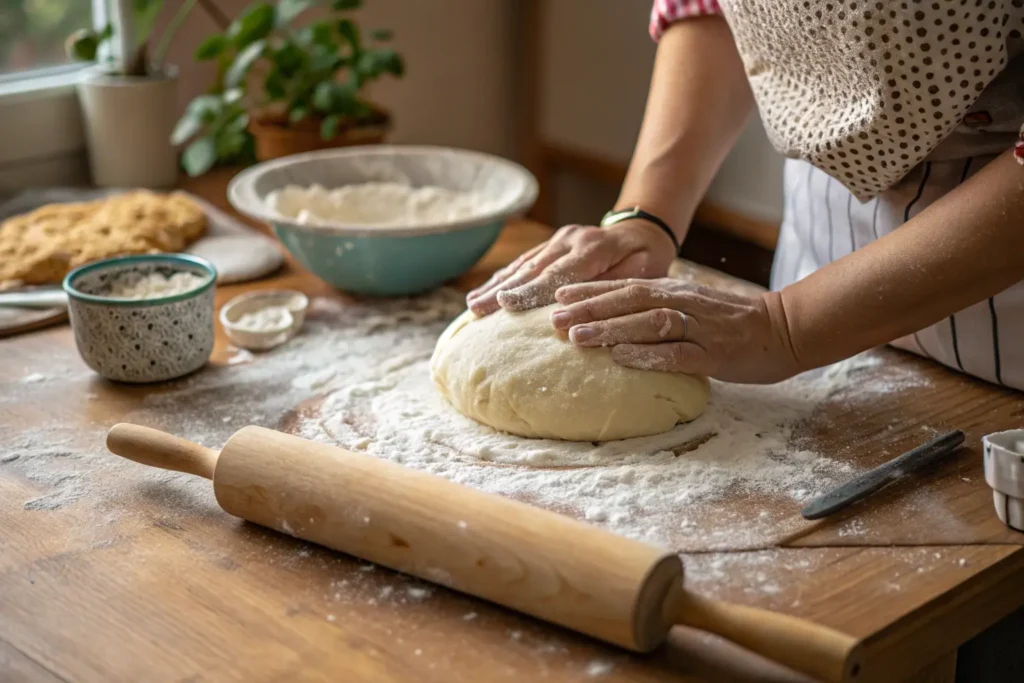
Start by mixing 3 cups of all-purpose flour, 2 teaspoons of instant yeast, 2 tablespoons of sugar, and 1 teaspoon of salt in a bowl. Add 1 cup of heated milk (around 110°F) and mix until the dough turns sticky. Work the dough on a dusted countertop for 5-7 minutes until it’s soft and stretchy. This step builds the foundation for a light, airy Swiss pastry. Let it rest for 10 minutes while you prep the butter.
Secret #2 – Mastering Butter Lamination
Take ½ cup of cold unsalted butter and flatten it between parchment paper into a thin rectangle. Roll your dough into a larger rectangle, place the butter in the center, and fold the dough over it like a letter. Roll it out again, fold, and repeat 3-4 times. This lamination process is what gives Gipfeli its flaky pastry layers. Keep the butter cold—pop it in the fridge between folds if it softens. The result? A dough that puffs up beautifully in the oven.
Secret #3 – Proper Proofing for Airy Texture
Place your laminated dough in a greased bowl, cover it with a damp cloth, and let it rise in a warm spot for 1-2 hours. It should double in size. This proofing step traps air, making your Gipfeli light and fluffy. Don’t rush it—patience pays off with that perfect texture.
Secret #4 – Shaping the Classic Crescent
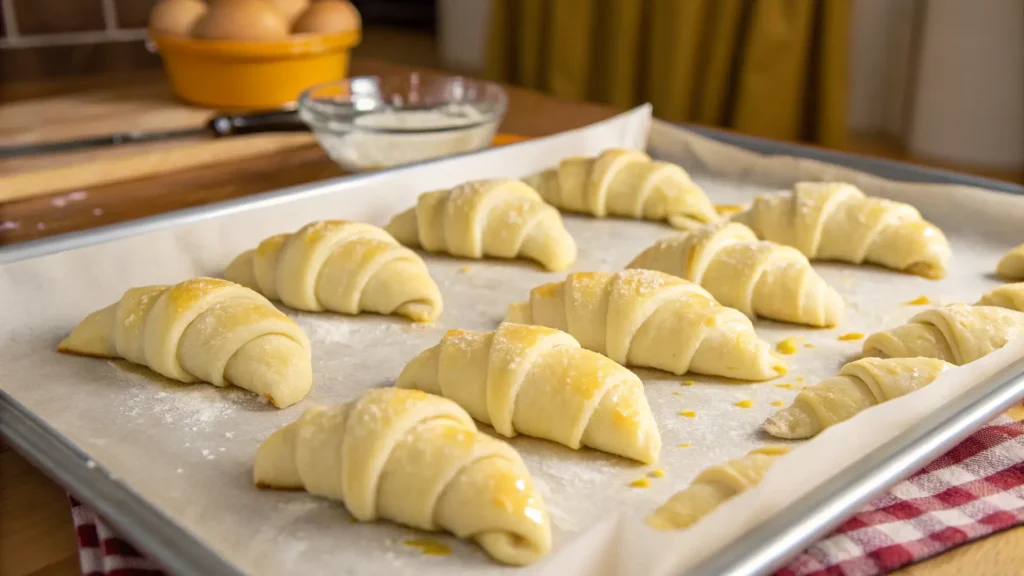
Stretch the dough into a wide rectangle roughly ¼-inch in thickness. Cut it into long triangles (about 4 inches wide at the base). Starting at the wide end, roll each triangle toward the point to form that iconic crescent shape. Curve the ends slightly for the classic look. Place them on a baking sheet lined with parchment, leaving space to expand. Brush with a beaten egg for a glossy finish.
Secret #5 – Baking to Golden Perfection
Preheat your oven to 375°F (190°C). Bake the Gipfeli for 15-20 minutes until they turn a rich golden brown. The kitchen will fill with a buttery aroma that’s hard to resist. Watch closely—overbaking can dry them out. Pull them out, let them cool slightly, and enjoy the fruits of your labor!
This process might sound detailed, but it’s straightforward once you get going. Each step builds on the last, turning simple ingredients into a traditional Swiss delight. Want to know more tricks? Let’s explore the full seven secrets next!
The 7 Secrets to Exceptional Gipfeli
Ready to take your Gipfeli recipe to the next level? These seven secrets ensure your pastries turn out bakery-worthy every time.
Secret #6 – Temperature Control for Success
Temperature is everything. Keep your butter cold (around 40°F) to maintain those flaky layers during lamination. The dough itself should stay at 68-72°F (20-22°C) while proofing—too warm, and the butter melts; too cold, and the yeast slows down. Use a thermometer if you’re unsure. This balance is key to a perfect rise and texture.
Secret #7 – Avoiding Common Pitfalls
Mistakes happen, but they’re easy to dodge. Don’t overwork the dough—it gets tough. Skipping proofing flattens your pastries. And if the baking temperature is off (too low or too high), you’ll miss that golden crunch. Stick to the steps, and you’ll avoid these common mistakes.
Recap of Secrets 1-5
Let’s tie it together: Secret #1 perfects the dough with proper kneading. Secret #2 masters lamination for flakiness. Secret #3 ensures proofing for airiness. Secret #4 shapes the crescent just right. Secret #5 bakes them to golden perfection at 375°F. These steps build a solid foundation for success.
Bonus Tips from Swiss Bakers
Swiss pros swear by these extras: Let the dough rest overnight in the fridge for deeper flavor. Use high-quality unsalted butter—it makes a difference. And don’t skip the egg for brushing—it’s the secret to that shiny, professional look. These tweaks elevate your homemade Gipfeli to authentic Swiss standards.
Master these secrets, and you’ll be asking, “What’s the secret to flaky Gipfeli?” no more—you’ll know it!
Variations on the Traditional Swiss Pastry Recipe
Love experimenting? Here are some fun twists on the classic Gipfeli recipe.
Sweet Gipfeli Ideas
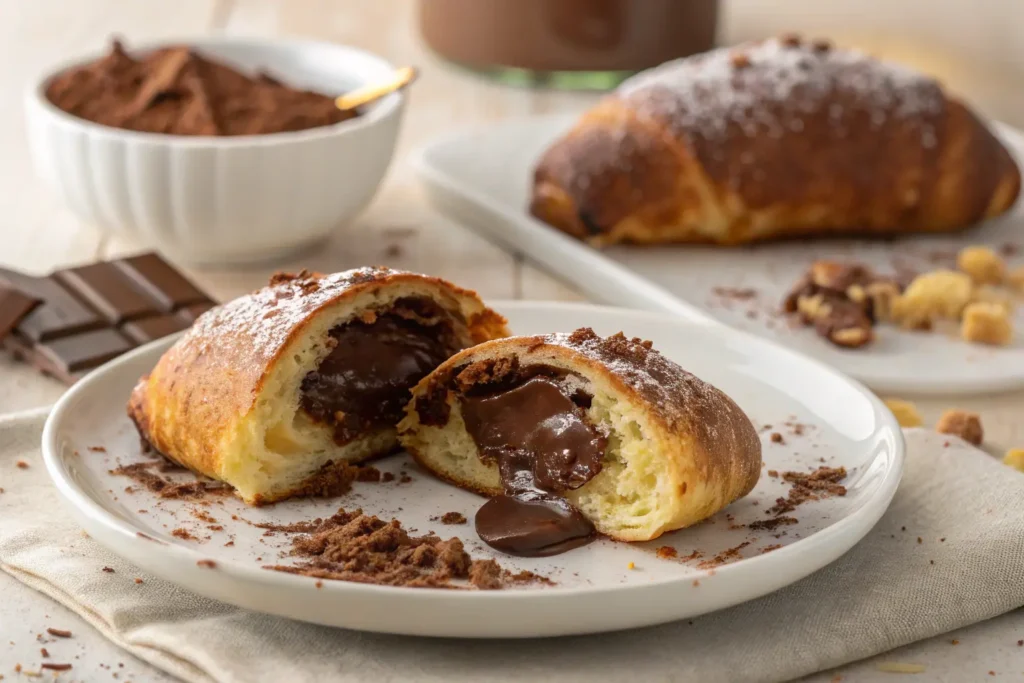
For a sugary treat, stuff your Gipfeli with chocolate chunks before rolling—think melty goodness in every bite. Or spread jam (strawberry or apricot work great) for a fruity burst. Almond paste adds a nutty richness that’s hard to beat.
Savory Twists for Dinner Rolls
Go savory with shredded cheese (Gruyère is very Swiss) or bits of ham tucked inside. Sprinkle herbs like rosemary on top for extra flavor. These make great dinner rolls or snacks.
Vegan and Gluten-Free Alternatives
For a vegan Gipfeli, swap butter for plant-based margarine and skip the egg wash—use warm milk alternatives like almond milk. Gluten-free? Try a blend of rice and tapioca flour, though the texture might differ slightly.
These fillings and tweaks let you play with the recipe while keeping that Swiss pastry vibe. Curious about common fillings for Gipfeli? These options cover the classics and beyond!
Alt text for hypothetical image: Chocolate-filled Gipfeli sliced open on a plate.
Storing and Reheating Your Homemade Pastries
Fresh Gipfeli are irresistible, but what about leftovers? Here’s how to store Gipfeli and keep them tasty.
Keep them at room temperature in an airtight container for 1-2 days—they’ll stay soft and flaky. For longer storage, freeze them in a zip-lock bag for up to a month. Wondering, ‘Can I freeze Gipfeli dough?’ Yes! Shape it, freeze it, and bake later—just add extra proofing time.
For reheating, place them in the oven at 350°F (175°C) for 5 to 10 minutes. The crispness comes back, and they’ll taste almost fresh-baked. Avoid the microwave—it turns them soggy. With these tips, you’ll enjoy your homemade pastries anytime.
Gipfeli vs. Croissants: What Sets Them Apart?
People often ask, “What’s the difference between Gipfeli and croissants?” Let’s clear it up.
Gipfeli, the Swiss croissant, uses less butter than croissants, making it less greasy and slightly denser. Croissants are fluffier and richer, a French indulgence, while Gipfeli is a practical breakfast pastry in Switzerland. Both share that crescent shape, but Gipfeli’s texture is firmer.
Here’s a quick comparison:
| Feature | Gipfeli | Croissant |
|---|---|---|
| Butter Content | Lower | Higher |
| Texture | Firmer, Flaky | Light, Airy |
| Origin | Swiss | French |
Both are delicious, but Gipfeli’s simplicity shines in this Gipfeli recipe.
Frequently Asked Questions About Gipfeli Recipe Mastery
Got questions? Here are answers to common queries about Gipfeli and croissants.
What Is a Mistake When Making Croissants (and Gipfeli)?
A big mistake is overworking the dough or letting the butter get too warm. This ruins the lamination, leaving you with dense, flat pastries instead of flaky ones. Keep it cool and gentle.
What Is the Difference Between a Croissant and a Gipfeli?
Gipfeli has less butter and a denser texture than a croissant. It’s a Swiss pastry with a subtle sweetness, while croissants are richer and airier, rooted in French tradition.
What Temperature Should Croissant Dough Be (and Gipfeli)?
Aim for 68-72°F (20-22°C). Too cold, and the yeast stalls; too warm, and the butter melts into the dough. This range ensures a perfect rise for your Gipfeli recipe.
Can You Prep Croissants (or Gipfeli) Ahead of Time?
Yes! Shape your Gipfeli, refrigerate overnight, and bake fresh in the morning. Or freeze unbaked pastries—thaw, proof, and bake when ready. It’s a time-saver for busy bakers.
These answers tackle the top People Also Ask queries, making your baking smoother!
Troubleshooting Your Swiss Pastry Efforts
Not quite right? Here’s how to fix common Gipfeli recipe hiccups.
Why Is My Gipfeli Dense?
If they’re heavy, check your proofing time—did it rise enough? Stale yeast or a cold room could be the culprits. Aim for a warm spot and fresh ingredients next time.
How to Fix Flat or Greasy Pastries
Flat Gipfeli? The butter might’ve melted during lamination—keep it cold. Greasy ones mean too much butter leaked out; lower the baking temperature slightly (try 365°F) and watch the clock.
With these tweaks, you’ll nail that flaky perfection.
Serving Suggestions for Your Freshly Baked Gipfeli
Fresh Gipfeli deserve a spotlight. Serve them warm with a steaming cup of coffee or tea for a classic Swiss breakfast. Slather on jam or butter for extra yum, or slice them open for a chocolate or cheese sandwich.
Hosting a brunch? Arrange them on a platter with sweet and savory options—guests will love the variety. They’re also great for holidays, paired with hot chocolate. Wondering, “What’s the best time to eat Gipfeli?” Anytime you crave a treat!
Conclusion
Mastering this Gipfeli recipe is easier than you think, thanks to these seven secrets: perfect dough, expert lamination, proper proofing, precise shaping, ideal baking, temperature control, and avoiding pitfalls. You’re now equipped to bake Swiss pastries that rival any bakery. Whether you stick to the classic or try fillings like chocolate or cheese, the result is a golden, flaky delight.
Now, get ready and dive in! Your home will fill with a delightful aroma, and your palate will be thrilled. Share your Gipfeli pics or ask questions below—we’d love to hear how it went. Happy baking!

